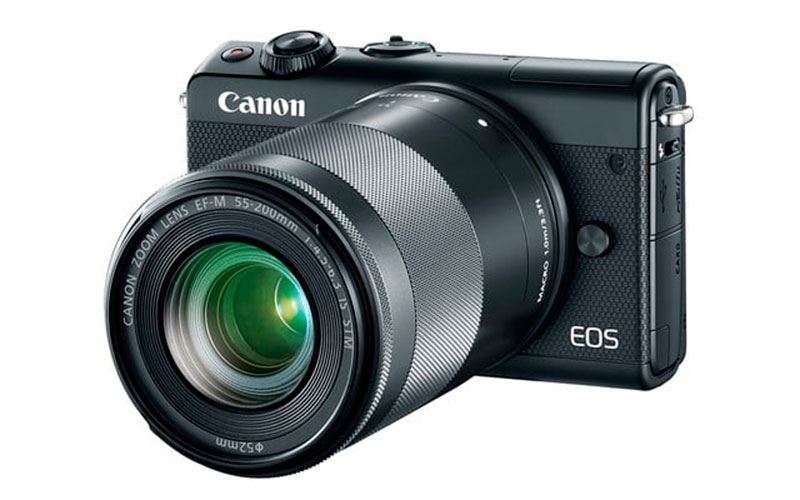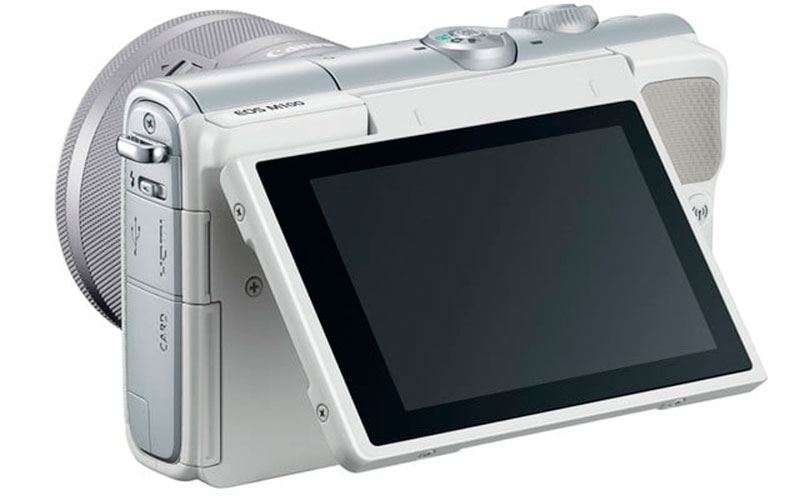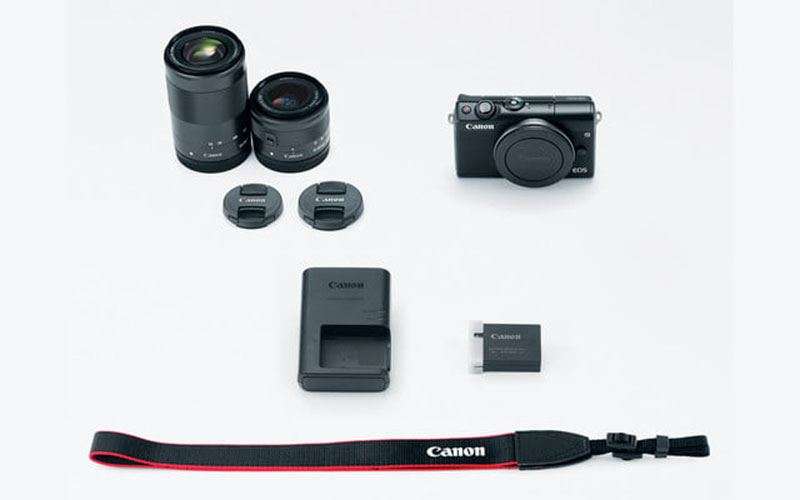Canon EOS M100
Содержание
Conclusion
While the significant improvements in smartphone image quality are having a big impact on the compact and entry-level consumer camera market, there’s still demand for cameras with physically larger sensors that are versatile enough to deliver good-quality images in challenging lighting conditions. Packing a large 24.2Mp APS-C sensor into a small and simplified camera, Canon’s EOS M100 looks to address this section of the market.
For budding photographers looking to take a step up from the smartphone, the EOS M100 is a user-friendly entry into the world of interchangeable lens cameras and the creative possibilities they bring. For more seasoned users, the lack of an EVF, hot shoe, and more advanced body-mounted controls for quicker operation might frustrate a little, but they’re not the EOS M100’s target market.
The same (or very similar) sensor as we’ve seen in the larger and slightly more expensive Canon EOS M5 and M6 hybrid cameras delivers comparable results for image quality. In fact, the EOS M100 just nudges out its predecessors to become the top-ranked Canon hybrid sensor we’ve tested, offering color sensitivity, dynamic range, and noise performance that’s very close to that of recent Canon APS-C DSLRs, too.
In this review we have compared the Canon EOS M100 to its most direct rivals that we’ve tested. As usual, you can create your own comparisons and in-depth analyses using our interactive image sensor ranking tool.
Новая компактная камера Canon EOS M100
Компания Canon предлагает новый вариант для начинающих энтузиастов фотографии, которые хотят выйти из тени смартфонов и окунуться в мир фотокамер. Объявленная 29 августа, Canon EOS M100 — камера начального уровня, упакованная внутри самого маленького корпуса серии М.
24-мегапиксельный CMOS-датчик APS-C внутри M100 предназначен для повышения эффективности работы со смартфоном, в то время, как переработанный сенсорный интерфейс упрощает переход для любителей смартфонов. Это, по мнению Canon, упрощает переключение режимов, к примеру, если надо изменить настройки или настроить фокус. Наклонный экран вращается на 180 градусов, предлагая возможность съёмки по неудобным углам или селфи.

Датчик APS-C сопряжён с процессором Canon Digic 7 и частотой пакетной передачи 4 кадра в секунду (fps) или 6.1 кадра в секунду с фокусом, установленным на первом кадре. Камера EOS M100 приносит автофокус Canon Dual-Pixel к беззеркальному начальному уровню, для более плавной и быстрой автофокусировки, с новейшими DSLR.
Использование и возможности
Фотокамера не предлагает 4K, что неудивительно для бюджетной модели, но видео 1080p всё ещё может обеспечить частоту 60 кадров в секунду. Canon EOS M100 также включает в себя ряд вариантов съёмки для новичков. Меню Creative Assist позволяет пользователям выполнять такие задачи, как размывание фона или увеличение яркости изображения, не зная технических терминов для диафрагмы и экспозиции. В Canon говорят, что эта функция призвана помочь новичкам научиться дальнейшему совершенствованию своих навыков фотографии. Камера также включает режим управления подсветкой HDR, творческие фильтры, режим автопортрета и экспозицию.

Из подключения, в M100 имеется Bluetooth, который всегда поддерживает сопряжённое соединение между камерой и телефоном, для геотегирования и беспроводной передачи. При удалённом управлении, RAW-фотографии и видео по-прежнему требуют более сильного Wi-Fi-соединения.
M100 заменит Canon EOS M10 вышедшую в 2015 году, с аналогичным дизайном и ценой. В отличие от более дорогого M5, M100 не имеет электронного видоискателя (EVF) и предлагает примерно половину скорости. Тем не менее EOS M100 — самая маленькая камера в M-серии, оснащённая тем же датчиком, что и M5.

Цена и доступность
Вариант без объективов не существует, поскольку он предназначен для новичков беззеркальных фотоаппаратов, которые, скорее всего, не владеют линзами.
Overall image sensor performance
The Canon EOS M100 achieves a very respectable overall DxOMark score of 78 points, making it the top-performing Canon hybrid camera we’ve tested. It delivers its best image quality at the lowest ISO sensitivity setting of ISO 100, where we recorded good color depth of 23.5 bits and dynamic range of 12.9 EV.
A device’s low-light ISO score is the highest ISO speed at which it meets three key thresholds: 18-bit color, 9 EV dynamic range, and a signal-to-noise ratio above 30 decibel. The EOS M100 achieved this at 1272 ISO, so you can be confident of good image quality when shooting in low-light environments up to this ISO setting. We conduct all our analyses on unprocessed RAW files, however, so with good image processing via the latest Canon DIGIC 7 processing engine, high-quality JPEG images at higher sensitivities such as ISO 1600 or 3200 should be well within the reach of the EOS M100.
In-depth comparisons
For more detail about sensor performance, our in-depth analysis takes a closer look at the Canon EOS M100 compared to some of the highest-scoring APS-C mirrorless sensors, the Sony A6300 and the Samsung NX1.
Portrait (Color Depth)
At their respective lowest ISO values (base ISO), two of the highest-scoring APS-C sensors we’ve tested are in the Sony A6300 and Samsung NX1, both of which offer a modest advantage for color sensitivity of around 2/3 stop, with scores of 24.4 bits and 24.2 bits , respectively, compared to 23.5 bits for the EOS M100. It’s a small difference, but for the best color rendition, the Sony and Samsung mirrorless cameras display slight improvements in color graduation on complex areas such as a sunset.
As ISO sensitivity is increased, color sensitivity deteriorates, which is true of all sensors. At low to mid ISO settings, the EOS M100 and Samsung NX1 display a similar downward trajectory, while the NX1 maintains around a half-stop advantage up to ISO 1600. The Canon sensor improves a little against the Samsung for color at high ISO settings, though, so at their highest ISO settings of 12,800 and 25,600, respectively, they’re effectively the same.
It’s not quite the same pattern when comparing the Canon and the Samsung to the Sony A6300, as not only does the Sony offer the best color at base ISO, but it continues to improve up to ISO 1600. This ensures that excellent color over 20 bits is possible on the A6300 at ISO 1600, compared to around ISO 800 on the NX1, and to ISO 640 on the EOS M100. Again, color deteriorates on the A6300 at higher ISO sensitivities, so between ISO 3200 to ISO 25,600, color rendition is much more comparable among the 3 sensors.

Landscape (Dynamic Range)
For dynamic range, which is a measure of how well a sensor captures extremes of luminosity from bright highlights to dark shadows, the Sony A6300 offers almost a whole stop better dynamic range compared to the EOS M100 at base ISO. That margin narrows slightly up to ISO ISO 400, but the Sony A6300 benefits from a significant uplift at the mid to high ISO settings. So while excellent dynamic range over 10 EV is possible on the EOS M100 up to ISO 800 (10.67 EV), the Sony A6300 continues to capture excellent dynamic range of 10.17 EV up to ISO 3200, giving it around a stop-and-a-half advantage. The Sony continues to improve for dynamic range at high ISO settings, too, making it a good choice for photographers regularly shooting in low-light conditions. The Samsung NX1’s broadly maintains its roughly 1/3-stop advantage for dynamic range over the EOS M100 up to ISO 800, but at higher sensitivity settings, the gap narrows, with the Samsung and Canon sensors offering the same results from ISO 3200 onwards.

Sports (Low-Light ISO)
Signal-to-noise ratios (SNR 18%) gives an indication where noise, or unwanted random variations, start to become visible in images. For printed images, the resolution of all sensors is “normalized” to a standard 12×8-inch print at 300 ppi, and the results among these three hybrid sensors are very comparable. For excellent results with very little visible noise, it’s best to shoot at low ISO settings up to ISO 200; and although noise continues to be well-controlled up to around ISO 1600, expect to see more digital interference in your prints if you shoot at very high ISO sensitivities.

Image quality compared
Featuring the same 24.2Mp APS-C sensor resolution as the more expensive Canon hybrid M5 and M6 models, the EOS M100 offers very similar image quality overall. Thanks to very modest improvements for both color depth (Portrait Score) and dynamic range (Landscape Score), however, the EOS M100 just nudges out its predecessors to rank as the best Canon hybrid sensor we’ve tested.
For color, the scores are very close, and in real-world terms we can say that they offer essentially the same image quality at base ISO. For dynamic range, however, its 1/3-stop improvement over the M6 (12.9 EV vs. 12.6 EV), and half-stop improvement over the M5 (12.9 Ev vs. 12.4 EV) make the EOS M100 slightly better suited for recording landscapes that include bright highlights and dark shadows. The slightly bigger and more expensive M6 model offers a small advantage for low-light performance (Sports score), but there’s barely anything in it and you can be confident of good image quality on the EOS M100 using high ISO sensitivities up to around ISO 1250 (and potentially higher with good JPEG processing).
Результаты тестирования Canon EOS M100
Характеристики и результаты тестирования Canon EOS M100
| Соотношение цена/качество |
|
| Тип камеры | |
| Эффективное количество пикселей | |
| Максимальное разрешение фото | |
| Тип сенсора | |
| Размеры сенсора | |
| Очистка сенсора | |
| Встроенный стабилизатор (в камеру) | |
| Запись видео | |
| Крепление объектива | |
| Объектив при оценке качества снимков | |
| Объектив при оценке быстродействия | |
| Минимальное время спуска затвора | |
| Максимальное время спуска затвора | |
| Видоискатель | |
| Покрытие видоискателя | |
| Увеличение видоискателя | |
| Дисплей: диагональ | |
| Дисплей: разрешение | |
| Дисплей: тачскрин | |
| Дисплей: запуск записи видео с тачскрина | |
| Дисплей: возможность поворота | |
| Дисплей: селфи-режим | |
| Второй дисплей | |
| Датчик ориентации | |
| GPS | |
| Минимальное ISO | |
| Максимальное ISO | |
| Мин. время синхронизации со вспышкой | |
| Баланс белого (кол-во предустановок) | |
| Баланс белого: по шкале Кельвина | |
| Разрешение при ISO мин | |
| Разрешение при ISO 400 | |
| Разрешение при ISO 800 | |
| Разрешение при ISO 1600 | |
| Разрешение при ISO 3200 | |
| Разрешение при ISO 6400 | |
| Детализация при ISO мин | |
| Детализация при ISO 400 | |
| Детализация при ISO 800 | |
| Детализация при ISO 1600 | |
| Детализация при ISO 3200 | |
| Детализация при ISO 6400 | |
| Визуальный шум при ISO мин | |
| Визуальный шум при ISO 400 | |
| Визуальный шум при ISO 800 | |
| Визуальный шум при ISO 1600 | |
| Визуальный шум при ISO 3200 | |
| Визуальный шум при ISO 6400 | |
| Экспертная оценка: шумность и детализация при ISO мин | |
| Экспертная оценка: шумность и детализация при ISO 1600 | |
| Экспертная оценка: шумность и детализация при ISO 3200 | |
| Экспертная оценка: шумность и детализация при ISO 6400 | |
| Время готовности к съемке из выключенного состояния | |
| Время задержки спуска затвора при ручной фокусировке | |
| Время задержки спуска затвора с автофокусом при дневном свете | |
| Время задержки спуска затвора с автофокусом при слабом освещении | |
| Время задержки спуска затвора в режиме Live-View с автофокусом при дневном свете | |
| Скорость серийной съемки в RAW | |
| Длина серии в RAW | |
| Скорость серийной съемки в JPEG | |
| Длина серии в JPEG | |
| Аккумулятор | |
| Стоимость аккумулятора | |
| Аккумулятор: макс. фотографий со вспышкой | |
| Аккумулятор: макс. фотографий без вспышки | |
| Аккумулятор: макс. фотографий в Live-View со вспышкой | |
| Аккумулятор: макс. фотографий в Live-View без вспышки | |
| Аккумулятор: продолжительность записи видео | |
| Разъем для микрофона | |
| Встроенная вспышка | |
| Управление вспышкой | |
| Дистанционный спуск затвора | |
| Тип карты памяти | |
| WLAN | |
| NFC | |
| Материал корпуса | |
| Корпус: защита от пыли и водяных брызг | |
| Габариты | |
| Вес без объктива |
